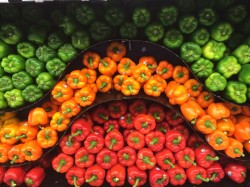All About Food | January 29th, 2016

A few years ago I came across the term “food desert.” I was intrigued and then struck by the seriousness of the matter and wrote about it in this paper. Recently, I discovered that a national organization in conjunction with others is spearheading a plan to get healthier foods into the mouths of people who really need them, mainly the underprivileged segment of our population who tend to survive on foods that lend themselves to obesity, diabetes, and which lead to pitiable health.
I wanted to learn more about their program and in doing so educated myself on issues that are probably common knowledge to most -- like the SNAP card program, which stands for Supplemental Nutrition Assistance Program, which replaced the food stamp program. I must admit it has a nice ring to it. Here are a few eye-opening tidbits about the SNAP program in North Dakota. The state spends seven million a month supplementing 27,200 households around the state, of which 44% have children and 42% having a working adult in them. A lot of this assistance is provided to migrant or seasonal workers.
The SNAP program is federal and falls under the FNS or food and nutrition service which in turn is under the USDA (United States Department of Agriculture). What I am hearing here is the use of the word “nutrition” in two of the departmental titles. Which brings me to the program I discovered in Mississippi and Tennessee, reportedly two of the worst states for food nutrition/food insecurity. The SNAP card can only be used for food at participating grocery stores and to my surprise farmers markets. How cool is that?
The pilot program in these two states is called Fre$h Savings and focuses on produce with some heady incentives. Shoppers at Kroger supermarkets (a large chain grocery throughout the South) can receive a coupon for a 50% discount on fresh produce if they use their SNAP card to purchase $10.00 of fresh fruits and vegetables. They can also receive $10.00 in tokens for fresh produce when they use their SNAP card at various farmers markets.
Here is another shocker. AARP teamed up with United Healthcare to collaborate on the Fre$H Savings program. AARP has also implemented a program for older shoppers to better learn how to navigate grocery stores, so they can find the healthiest items which fit into their budgets.
In Philadelphia, ShopRite stores have moved into two former “food deserts” and offer on-site dietitians along with a health clinic. These services are in place to educate customers and supply recipes for healthy eating. They can also get coupons to use their SNAP cards at certain farmers markets and stores which can allow them the opportunity to get twice the amount of fresh produce than they could with food stamps. This program was the accomplished through the efforts of Wholesome Wave, a chef-driven nonprofit getting better foods into low income neighborhoods. I have contacted Wholesome Wave who are presently in 38 states and guess what, we aren’t one of the 38.
We need to bring Wholesome Wave into our community. Founder chef Michel Nischan, a three-time James Beard Award winner, has put together a team and created an organization that includes 730 farmers markets and other extraordinarily concerned civilians. They promote nutrition incentive programs nationally and globally. With our strong farm to table movement it’s a perfect fit.
November 18th 2025
November 12th 2025
September 16th 2025
August 19th 2025
July 15th 2025

_(1)__293px-wide.png)
_(1)_(1)_(1)__293px-wide.jpg)

__293px-wide.jpg)
_(1)__293px-wide.jpg)